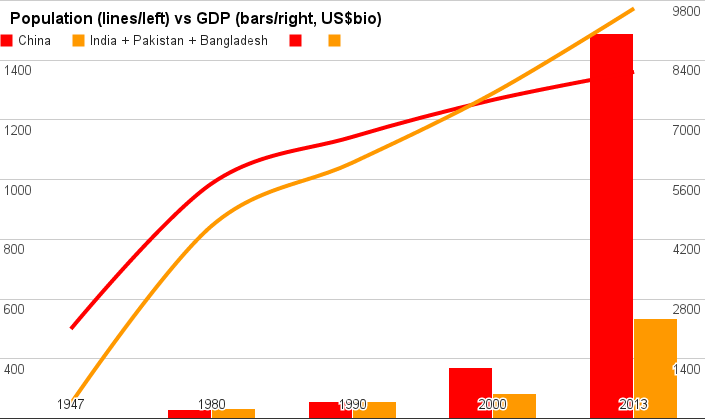In 1947, the land of British India (not including Burma, whose then 9 million split off in 1937) was home to about 250 million people, or about half of the estimated 500 million living in mainland China at the time. It was only around 1999 that the combined populations of India, Pakistan, and Bangladesh (the successor slices of the former British Raj which I will collectively call “the subcontinent” here) surpassed China’s then population of 1.26 billion. By 2013, these three countries’ 1.58 billion exceeds China’s 1.36 billion by 220 million people – a gap in just 14 years almost as large as Asia’s third biggest country (Indonesia), and almost three times larger than that of the most populous union in Europe (re-unified Germany). In just one more decade, the Republic of India’s population may surpass China’s, while its partitioned off neighbors may have more heads than in the US.
Where South Asia has been outgrowing China demographically, it has far more dramatically undergrown China economically. It may be hard to imagine today, but as late as 1990, China’s economy was still smaller than that of the subcontinent, and even in 1994 the mainland’s GDP was little more than double that of Taiwan – yes, tiny Taiwan whose entire population is smaller than those of Shanghai, Chongking, or Canton. After China’s blinding decade of economic outperformance since 2000, China seems so far ahead of India, let alone Pakistan or Bangladesh, that one rarely sees any comparisons of these economies in one sentence.
It might be a bit of an exaggeration, but I would say the 1947 partition deserves much of the blame for dragging the former Raj’s performance so far, and as I see it, also has left some undervalued potential that may only be seen later this century. The legacy of the partition is that over 60 years later, the India-Pakistan, and to some extent the India-Bangladesh, border acts as almost the opposite of a free trade zone. I’ve never been there myself (though have been wanting to take the train from London to Delhi), so have to rely on the numbers: last year, India exported a mere US$2bio to Pakistan, less than its exports to Iran, Tanzania, or the Bahamas. Its US$3.7bio of exports to its smaller neighbor of Bangladesh is slightly better, but still only half of what India exports to the 11 million people of Belgium.

There are several examples of partitions and re-unifications in history, but none I can think of come close to the scale and potential of seeing greater trade between India and its own neighbors. North India already has the advantage of common languages in the split provinces in the west (Urdu, Punjabi, Kashmiri and Sindhi) and in the east (Bengali), although one could compare how much good that’s done Latin America or the Middle East. Unlike Latin America, and perhaps more like Ireland, more of the discussion tends to center around the religious and political differences which led to the partition and ongoing division. I was surprised to see in a recent magazine on the 66th anniversary of partition many letters saying it was a good thing – citing terrorism or religious partisanship. I am still far from an expert on the geopolitics of that part of the world, but do believe a united India would have been a far poorer support base for terrorists than the partitioned Pakistan has been — imagine what happened to the KKK after the US reconstructed, except more now-Pakistanis might have moved to Bangalore for IT jobs. Economically though, I find it very difficult to see any upside partition has brought the subcontinent over the past 66 years, and hope I am not too optimistic in expecting closer ties and more cross-border trade helping these 1.5 billion people catch up with, and perhaps surpass, China later this century.

[Source: TIME magazine 27 October 1947]

